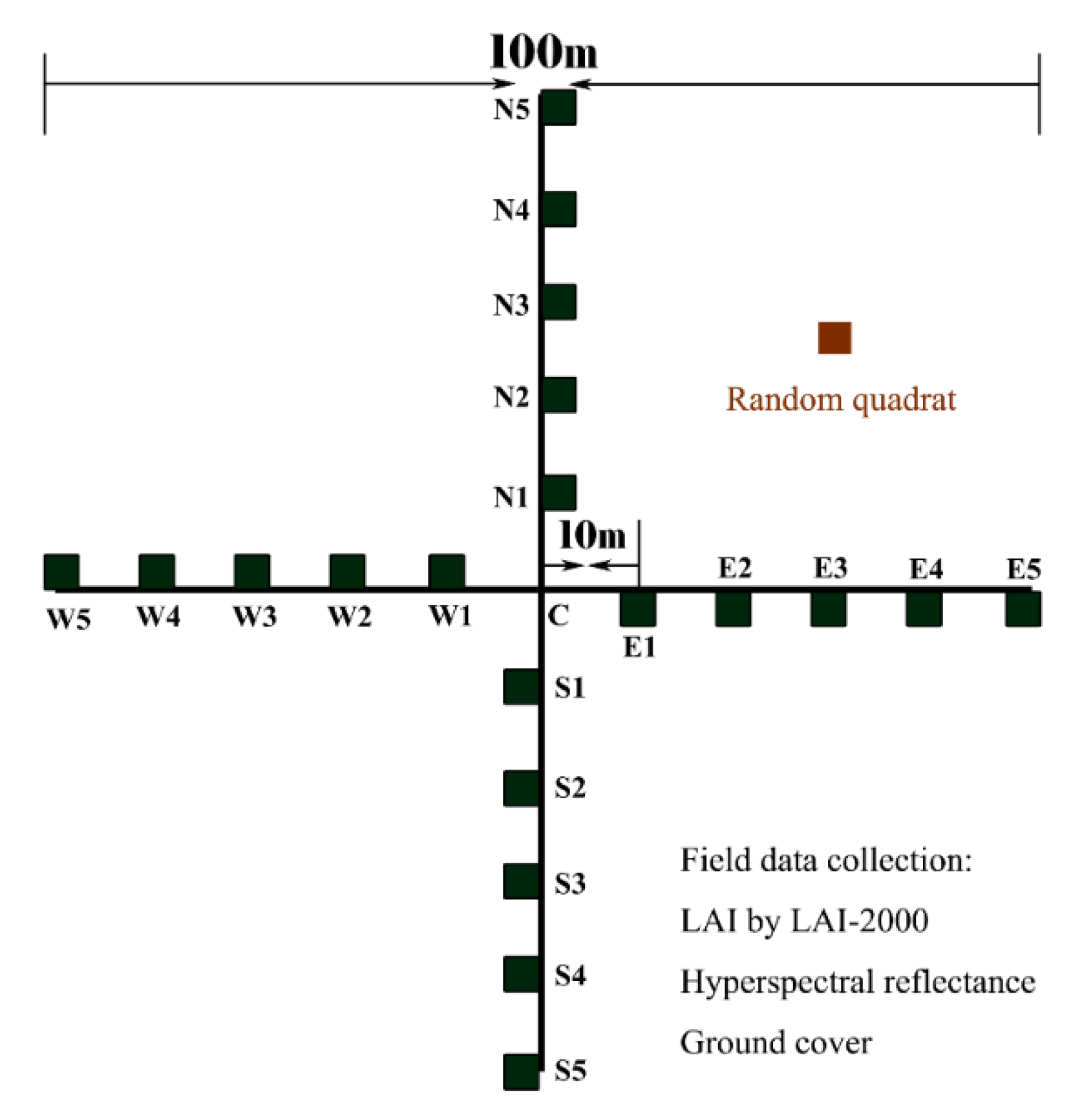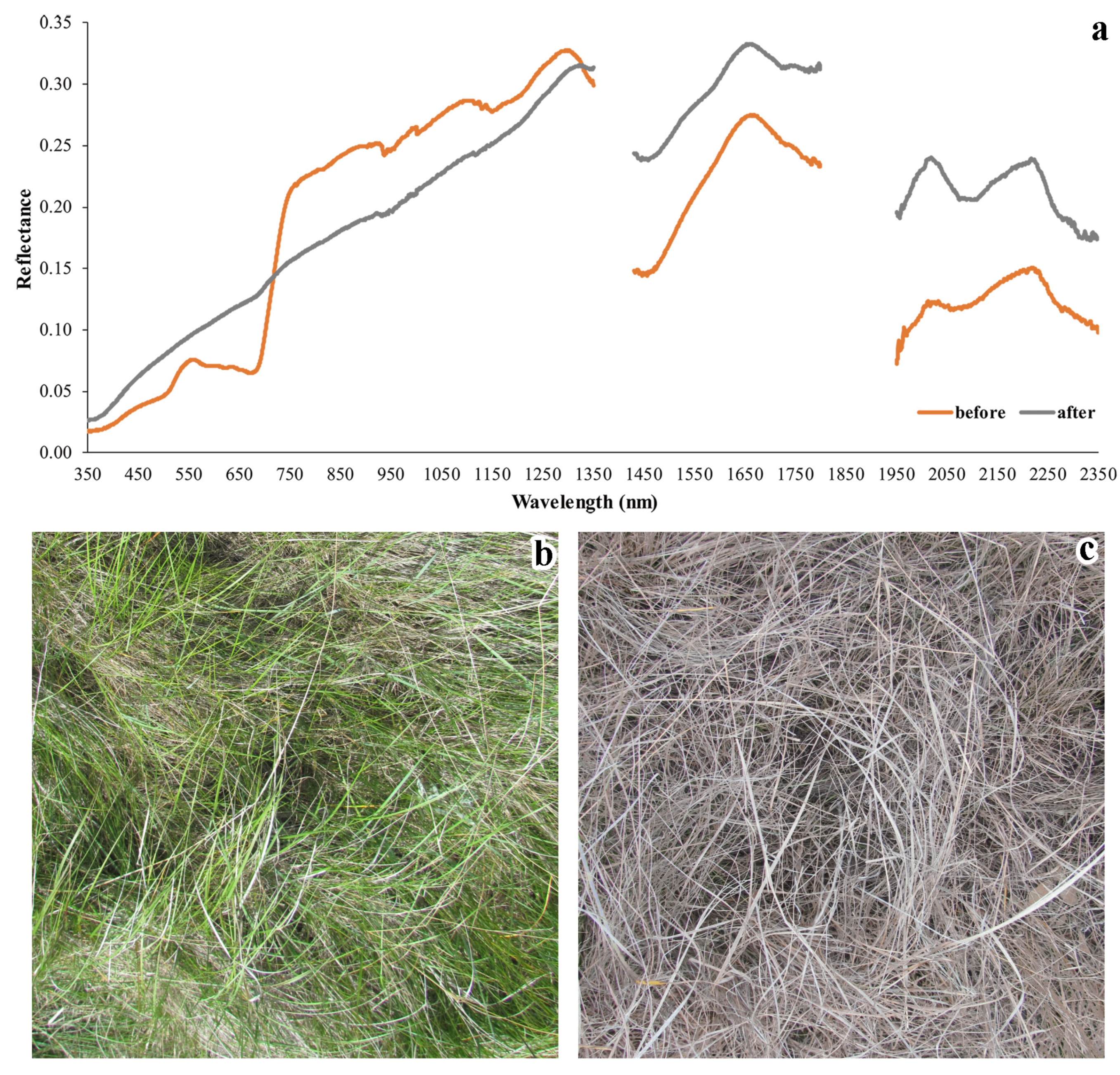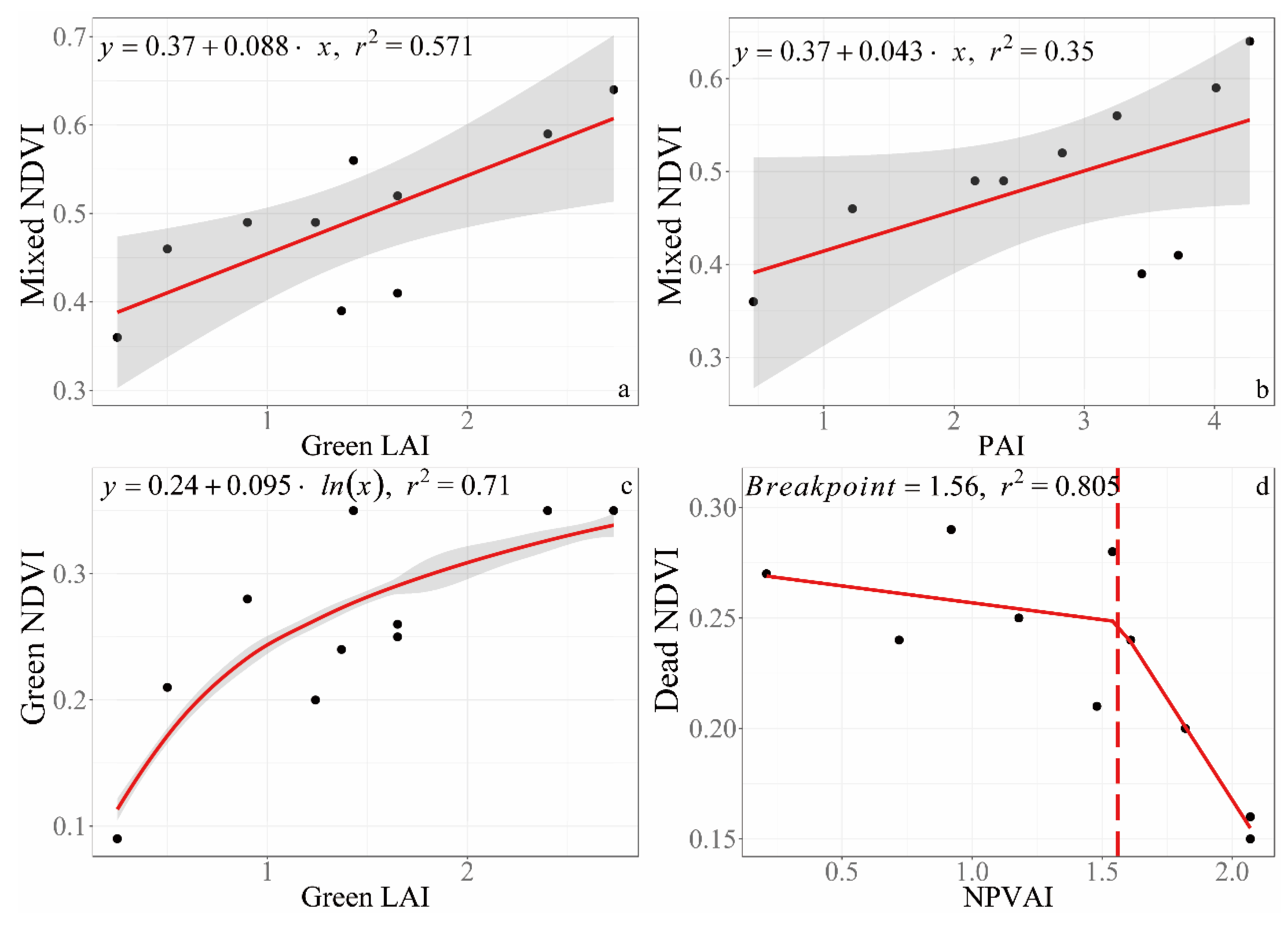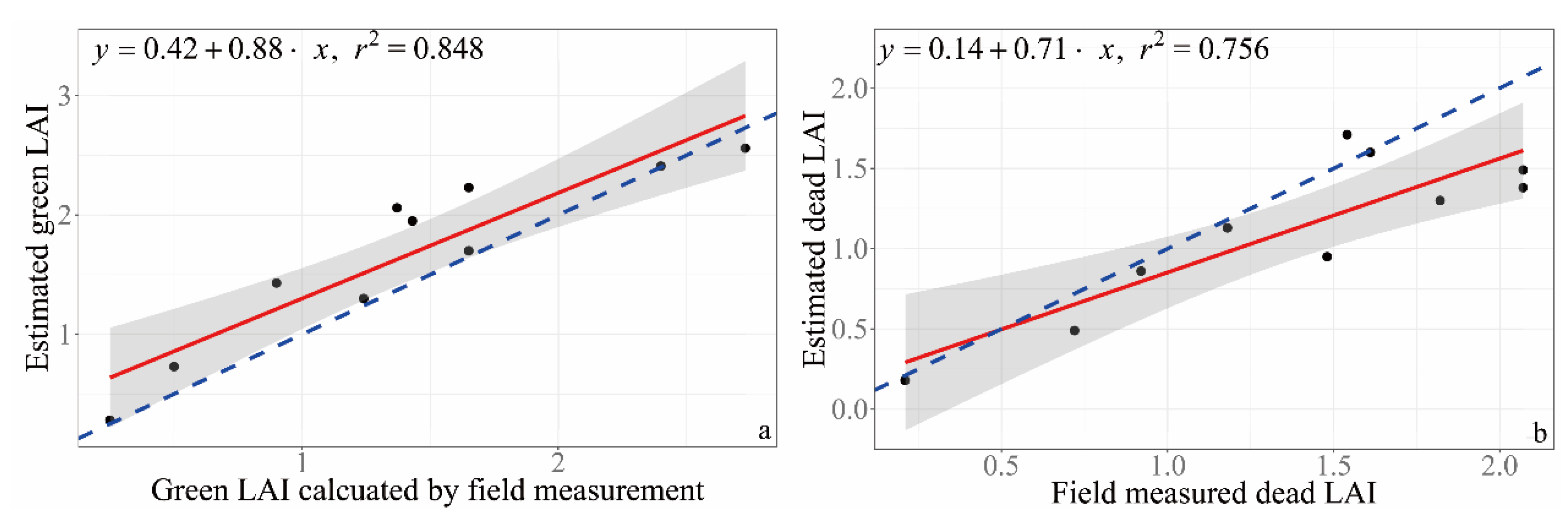The Impact of Non-Photosynthetic Vegetation on LAI Estimation by NDVI in Mixed Grassland
Abstract
:1. Introduction
2. Methods
2.1. Study Area
2.2. Data Collection
2.3. The Relationship between Green Leaf Area Index (LAI), Photosynthetic Matter Area Index (NPVAI), Plant Area Index (PAI) and Green, Dead, and Mixed Normalized Difference Vegetation Index (NDVI)
2.4. Impact of NPV on Field Measured LAI by LAI-2000
3. Results
3.1. The Relationship between Green, Dead, PAI and Green, Dead, Mixed NDVI
3.2. Contribution of GV and NPV Cover on Field Measured PAI by LAI-2000
3.3. Validation of the Estimated Green LAI and NPVAI
4. Discussion
4.1. The Relationship between NDVI and LAI
4.2. Contribution of GV and NPV on In-Situ Measured PAI
5. Conclusions
Author Contributions
Funding
Acknowledgments
Conflicts of Interest
Appendix A
| Abbreviations | Terms |
|---|---|
| LAI | Leaf Area Index |
| NDVI | Normalized Difference Vegetation Index |
| NPV | Non-Photosynthetic Vegetation |
| NPVAI | Non-Photosynthetic Matter Area Index |
| PAI | Plant Area Index |
| GV | Green Vegetation |
| GNP | Grasslands National Park |
| ASD | Analytical Spectral Devices |
Appendix B
| Community Type | Before Removing Green Vegetation | After Removing Green Vegetation | Dominant Species | ||
|---|---|---|---|---|---|
| NDVIHyper | LAI | NDVIHyper | LAI | ||
| Disturbed community | 0.64 | 4.27 | 0.28 | 1.54 | Smooth brome Crested wheatgrass |
| Sloped grassland | 0.52 | 2.83 | 0.25 | 1.18 | Western wheatgrass Needle-and-thread grass Blue grama grass |
| Sloped grassland | 0.56 | 3.25 | 0.20 | 1.82 | Western wheatgrass Needle-and-thread grass Blue grama grass |
| Sloped grassland | 0.36 | 0.46 | 0.27 | 0.21 | Western wheatgrass |
| Sloped grassland | 0.46 | 1.22 | 0.24 | 0.72 | Western wheatgrass Needle-and-thread grass Blue grama grass |
| Sloped grassland | 0.49 | 2.16 | 0.29 | 0.92 | Needle-and-thread grass Blue grama grass |
| Upland grassland | 0.49 | 2.38 | 0.21 | 1.48 | Needle-and-thread grass Blue grama grass Northern wheatgrass |
| Upland grassland | 0.39 | 3.44 | 0.15 | 2.07 | Western wheatgrass |
| Valley grassland | 0.59 | 4.01 | 0.24 | 1.61 | Western wheatgrass Smooth brown Crested wheatgrass |
| Valley grassland | 0.41 | 3.72 | 0.16 | 2.07 | Western wheatgrass |
References
- Fang, H.L.; Li, W.J.; Myneni, R.B. The impact of potential land cover misclassification on modis leaf area index (LAI) estimation: A statistical perspective. Remote Sens. 2013, 5, 830–844. [Google Scholar] [CrossRef] [Green Version]
- Liu, X.H.; Wang, L. Feasibility of using consumer-grade unmanned aerial vehicles to estimate leaf area index in mangrove forest. Remote Sens. Lett. 2018, 9, 1040–1049. [Google Scholar] [CrossRef]
- Fang, H.L.; Liang, S.L.; Townshend, J.R.; Dickinson, R.E. Spatially and temporally continuous lai data sets based on an integrated filtering method: Examples from North America. Remote Sens. Environ. 2008, 112, 75–93. [Google Scholar] [CrossRef]
- Li, D.; Gu, X.F.; Pang, Y.; Chen, B.W.; Liu, L.X. Estimation of forest aboveground biomass and leaf area index based on digital aerial photograph data in Northeast China. Forests 2018, 9, 275. [Google Scholar] [CrossRef] [Green Version]
- Ryu, Y.; Verfaillie, J.; Macfarlane, C.; Kobayashi, H.; Sonnentag, O.; Vargas, R.; Ma, S.; Baldocchi, D.D. Continuous observation of tree leaf area index at ecosystem scale using upward-pointing digital cameras. Remote Sens. Environ. 2012, 126, 116–125. [Google Scholar] [CrossRef]
- Sakamoto, T.; Gitelson, A.A.; Wardlow, B.D.; Arkebauer, T.J.; Verma, S.B.; Suyker, A.E.; Shibayama, M. Application of day and night digital photographs for estimating maize biophysical characteristics. Precis. Agric. 2012, 13, 285–301. [Google Scholar] [CrossRef] [Green Version]
- Wan, H.W.; Wang, J.D.; Liang, S.L.; Fang, H.L.; Xiao, Z.Q. Estimating leaf area index by fusing modis and misr data. In Proceedings of the 2006 IEEE International Geoscience and Remote Sensing Symposium, Denver, CO, USA, 31 July–4 August 2006; IEEE: New York, NY, USA, 2006. [Google Scholar]
- Xu, D.D.; Guo, X.L.; Li, Z.Q.; Yang, X.H.; Yin, H. Measuring the dead component of mixed grassland with landsat imagery. Remote Sens. Environ. 2014, 142, 33–43. [Google Scholar] [CrossRef]
- Fan, X.; Liu, Y. A global study of ndvi difference among moderate-resolution satellite sensors. ISPRS J. Photogramm. Remote Sens. 2016, 121, 177–191. [Google Scholar] [CrossRef]
- Bai, Y.; Yang, Y.; Jiang, H. Intercomparison of AVHRR GIMMS3g, Terra MODIS, and SPOT-VGT NDVI products over the Mongolian plateau. Remote Sens. 2019, 11, 2030. [Google Scholar] [CrossRef] [Green Version]
- Albarakat, R.; Lakshmi, V. Comparison of normalized difference vegetation index derived from landsat, modis, and avhrr for the mesopotamian marshes between 2002 and 2018. Remote Sens. 2019, 11, 1245. [Google Scholar] [CrossRef] [Green Version]
- Xiong, Y.D.; West, C.P.; Brown, C.P.; Green, P.E. Digital image analysis of old world bluestem cover to estimate canopy development. Agron. J. 2019, 111, 1247–1253. [Google Scholar] [CrossRef] [Green Version]
- Sanches, G.M.; Duft, D.G.; Kolln, O.T.; Luciano, A.C.D.; De Castro, S.G.Q.; Okuno, F.M.; Franco, H.C.J. The potential for rgb images obtained using unmanned aerial vehicle to assess and predict yield in sugarcane fields. Int. J. Remote Sens. 2018, 39, 5402–5414. [Google Scholar] [CrossRef]
- Walthall, C.; Dulaney, W.; Anderson, M.; Norman, J.; Fang, H.L.; Liang, S.L. A comparison of empirical and neural network approaches for estimating corn and soybean leaf area index from Landsat ETM+ imagery. Remote Sens. Environ. 2004, 92, 465–474. [Google Scholar] [CrossRef]
- Fang, H.L.; Liang, S.L.; Kuusk, A. Retrieving leaf area index using a genetic algorithm with a canopy radiative transfer model. Remote Sens. Environ. 2003, 85, 257–270. [Google Scholar] [CrossRef]
- Fang, H.L.; Liang, S.L. Retrieving leaf area index with a neural network method: Simulation and validation. IEEE Trans. Geosci. Remote 2003, 41, 2052–2062. [Google Scholar] [CrossRef] [Green Version]
- Jiang, C.Y.; Ryu, Y.; Fang, H.L.; Myneni, R.; Claverie, M.; Zhu, Z.C. Inconsistencies of interannual variability and trends in long-term satellite leaf area index products. Glob. Change Biol. 2017, 23, 4133–4146. [Google Scholar] [CrossRef] [PubMed]
- Fang, H.L.; Liang, S.L. A hybrid inversion method for mapping leaf area index from MODIS data: Experiments and application to broadleaf and needleleaf canopies. Remote Sens. Environ. 2005, 94, 405–424. [Google Scholar] [CrossRef]
- Gu, Y.; Wylie, B.K.; Howard, D.M.; Phuyal, K.P.; Ji, L. NDVI saturation adjustment: A new approach for improving cropland performance estimates in the Greater Platte River Basin, USA. Ecol. Indic. 2013, 30, 1–6. [Google Scholar] [CrossRef]
- Liu, F.; Qin, Q.; Zhan, Z. A novel dynamic stretching solution to eliminate saturation effect in NDVI and its application in drought monitoring. Chin. Geogr. Sci. 2012, 22, 683–694. [Google Scholar] [CrossRef]
- Wang, Z.; Yao, F.; Li, W.; Wu, J. Saturation correction for nighttime lights data based on the relative NDVI. Remote Sens. 2017, 9, 759. [Google Scholar] [CrossRef] [Green Version]
- Houborg, R.; McCabe, M.F. A hybrid training approach for leaf area index estimation via cubist and random forests machine-learning. Isprs J. Photogramm. 2018, 135, 173–188. [Google Scholar] [CrossRef]
- Brantley, S.T.; Zinnert, J.C.; Young, D.R. Application of hyperspectral vegetation indices to detect variations in high leaf area index temperate shrub thicket canopies. Remote Sens. Environ. 2011, 115, 514–523. [Google Scholar] [CrossRef] [Green Version]
- Wang, Q.; Adiku, S.; Tenhunen, J.; Granier, A. On the relationship of NDVI with leaf area index in a deciduous forest site. Remote Sens. Environ. 2005, 94, 244–255. [Google Scholar] [CrossRef]
- Hashimoto, N.; Saito, Y.; Maki, M.; Homma, K. Simulation of reflectance and vegetation indices for unmanned aerial vehicle (UAV) monitoring of paddy fields. Remote Sens. 2019, 11, 2119. [Google Scholar] [CrossRef] [Green Version]
- Tan, C.-W.; Zhang, P.-P.; Zhou, X.-X.; Wang, Z.-X.; Xu, Z.-Q.; Mao, W.; Li, W.-X.; Huo, Z.-Y.; Guo, W.-S.; Yun, F. Quantitative monitoring of leaf area index in wheat of different plant types by integrating NDVI and Beer-Lambert law. Sci. Rep. 2020, 10, 929. [Google Scholar] [CrossRef] [PubMed]
- Zhang, L.; Qiao, N.; Baig, M.H.A.; Huang, C.; Lv, X.; Sun, X.; Zhang, Z. Monitoring vegetation dynamics using the universal normalized vegetation index (UNVI): An optimized vegetation index-viupd. Remote Sens. Lett. 2019, 10, 629–638. [Google Scholar] [CrossRef]
- Sun, Y.; Ren, H.; Zhang, T.; Zhang, C.; Qin, Q. Crop leaf area index retrieval based on inverted difference vegetation index and NDVI. IEEE Geosci. Remote Sens. Lett. 2018, 15, 1662–1666. [Google Scholar] [CrossRef]
- Cao, Z.; Cheng, T.; Ma, X.; Tian, Y.; Zhu, Y.; Yao, X.; Chen, Q.; Liu, S.; Guo, Z.; Zhen, Q.; et al. A new three-band spectral index for mitigating the saturation in the estimation of leaf area index in wheat. Int. J. Remote Sens. 2017, 38, 3865–3885. [Google Scholar] [CrossRef]
- Asam, S.; Fabritius, H.; Klein, D.; Conrad, C.; Dech, S. Derivation of leaf area index for grassland within alpine upland using multi-temporal rapideye data. Int. J. Remote Sens. 2013, 34, 8628–8652. [Google Scholar] [CrossRef]
- Li, Z.Q.; Guo, X.L. A suitable NDVI product for monitoring spatiotemporal variations of lai in semiarid mixed grassland. Can. J. Remote Sens. 2012, 38, 683–694. [Google Scholar] [CrossRef]
- He, Y.; Guo, X.L.; Wilmshurst, J. Studying mixed grassland ecosystems I: Suitable hyperspectral vegetation indices. Can. J. Remote Sens. 2006, 32, 98–107. [Google Scholar] [CrossRef]
- Zhang, J.; Yang, C.H.; Zhao, B.Q.; Song, H.B.; Hoffmann, W.C.; Shi, Y.Y.; Zhang, D.Y.; Zhang, G.Z. Crop classification and LAI estimation using original and resolution-reduced images from two consumer-grade cameras. Remote Sens. 2017, 9, 1054. [Google Scholar] [CrossRef] [Green Version]
- Lin, Q.A.; Huang, H.G.; Yu, L.F.; Wang, J.X. Detection of shoot beetle stress on yunnan pine forest using a coupled liberty2-inform simulation. Remote Sens. 2018, 10, 1133. [Google Scholar] [CrossRef] [Green Version]
- Nagai, S.; Saitoh, T.M.; Noh, N.J.; Yoon, T.K.; Kobayashi, H.; Suzuki, R.; Nasahara, K.N.; Son, Y.; Muraoka, H. Utility of information in photographs taken upwards from the floor of closed-canopy deciduous broadleaved and closed-canopy evergreen coniferous forests for continuous observation of canopy phenology. Ecol. Inform. 2013, 18, 10–19. [Google Scholar] [CrossRef]
- Li, Z.Q.; Guo, X.L. A suitable vegetation index for quantifying temporal variation of leaf area index (LAI) in semiarid mixed grassland. Can. J. Remote Sens. 2010, 36, 709–721. [Google Scholar] [CrossRef]
- Xu, D.D.; Guo, X.L. A study of soil line simulation from Landsat images in mixed grassland. Remote Sens. 2013, 5, 4533–4550. [Google Scholar] [CrossRef] [Green Version]
- Wu, C.; Niu, Z.; Tang, Q.; Huang, W. Estimating chlorophyll content from hyperspectral vegetation indices: Modeling and validation. Agr. For. Meteorol. 2008, 148, 1230–1241. [Google Scholar] [CrossRef]
- Xu, D.D.; Koper, N.; Guo, X.L. Quantifying the influences of grazing, climate and their interactions on grasslands using landsat tm images. Grassl. Sci. 2018, 64, 118–127. [Google Scholar] [CrossRef]
- Pan, G.; Li, F.M.; Sun, G.J. Digital camera based measurement of crop cover for wheat yield prediction. In Proceedings of the Igarss: 2007 IEEE International Geoscience and Remote Sensing Symposium, Barcelona, Spain, 23–27 June 2007; IEEE: New York, NY, USA, 2007. [Google Scholar]
- Diago, M.P.; Correa, C.; Millan, B.; Barreiro, P.; Valero, C.; Tardaguila, J. Grapevine yield and leaf area estimation using supervised classification methodology on rgb images taken under field conditions. Sensors 2012, 12, 16988–17006. [Google Scholar] [CrossRef] [Green Version]





| Site Data | Coefficient | Sum Sq | F | P | Explained Variation (%) | Relative Effects (%) |
|---|---|---|---|---|---|---|
| dead cover | 0.04151 | 60.532 | 68.333 | <0.001 | 15.45% | 39.67% |
| green cover | 0.04139 | 92.056 | 103.92 | <0.001 | 23.50% | 60.33% |
| residual | 239.177 | |||||
| total | 391.765 | 38.95% | 100.00% |
© 2020 by the authors. Licensee MDPI, Basel, Switzerland. This article is an open access article distributed under the terms and conditions of the Creative Commons Attribution (CC BY) license (http://creativecommons.org/licenses/by/4.0/).
Share and Cite
Xu, D.; An, D.; Guo, X. The Impact of Non-Photosynthetic Vegetation on LAI Estimation by NDVI in Mixed Grassland. Remote Sens. 2020, 12, 1979. https://doi.org/10.3390/rs12121979
Xu D, An D, Guo X. The Impact of Non-Photosynthetic Vegetation on LAI Estimation by NDVI in Mixed Grassland. Remote Sensing. 2020; 12(12):1979. https://doi.org/10.3390/rs12121979
Chicago/Turabian StyleXu, Dandan, Deshuai An, and Xulin Guo. 2020. "The Impact of Non-Photosynthetic Vegetation on LAI Estimation by NDVI in Mixed Grassland" Remote Sensing 12, no. 12: 1979. https://doi.org/10.3390/rs12121979






